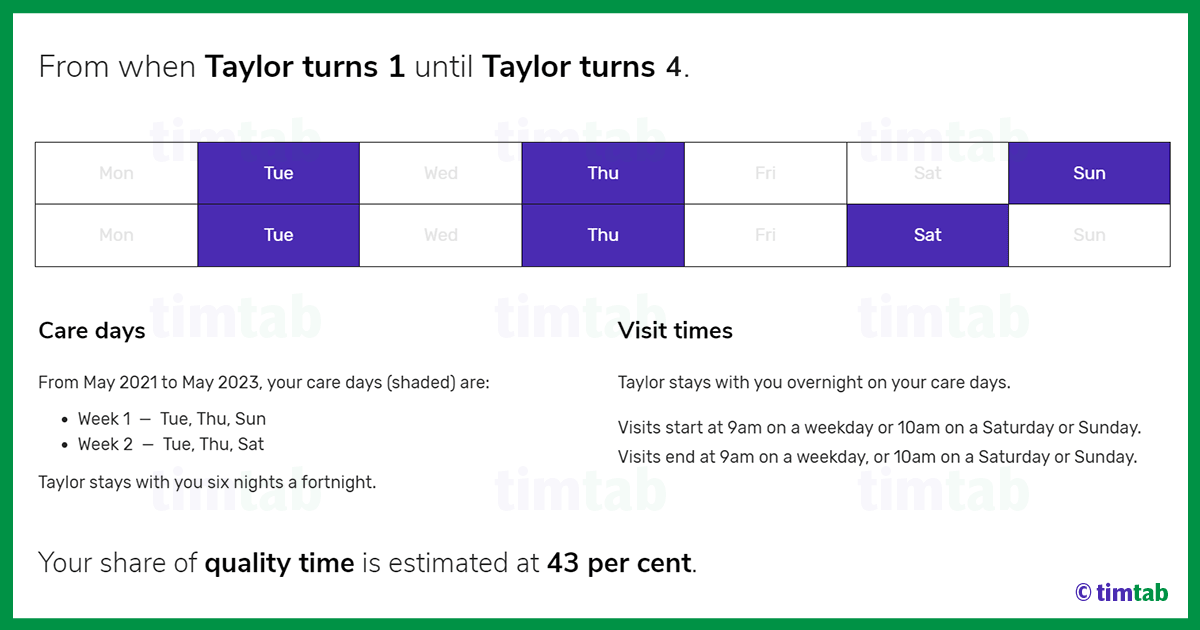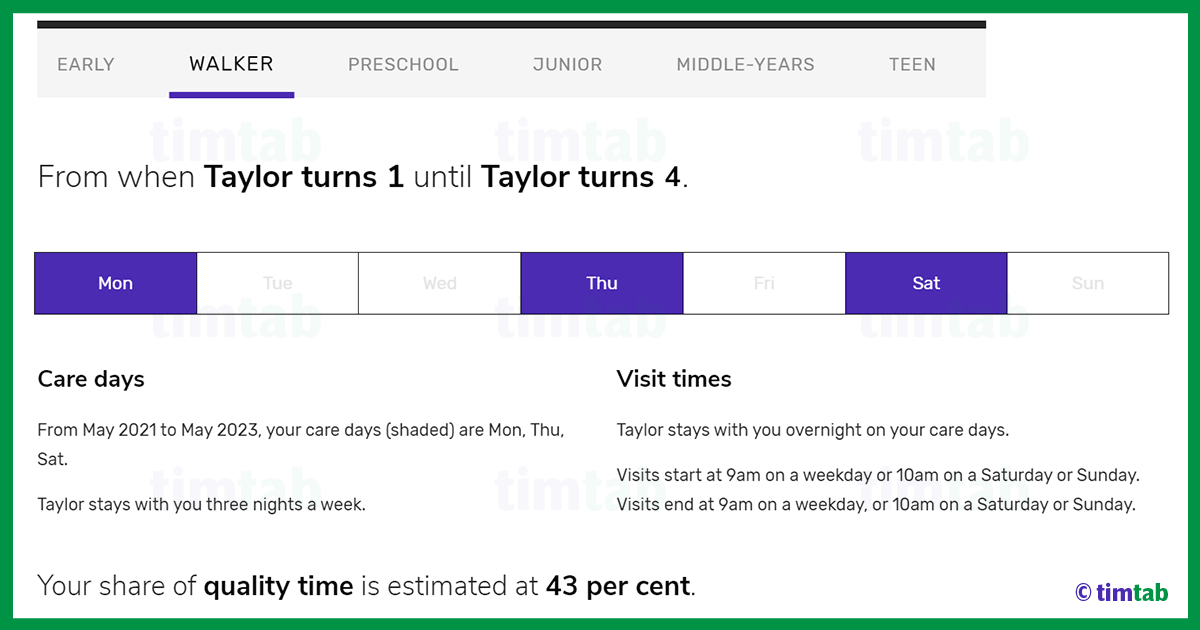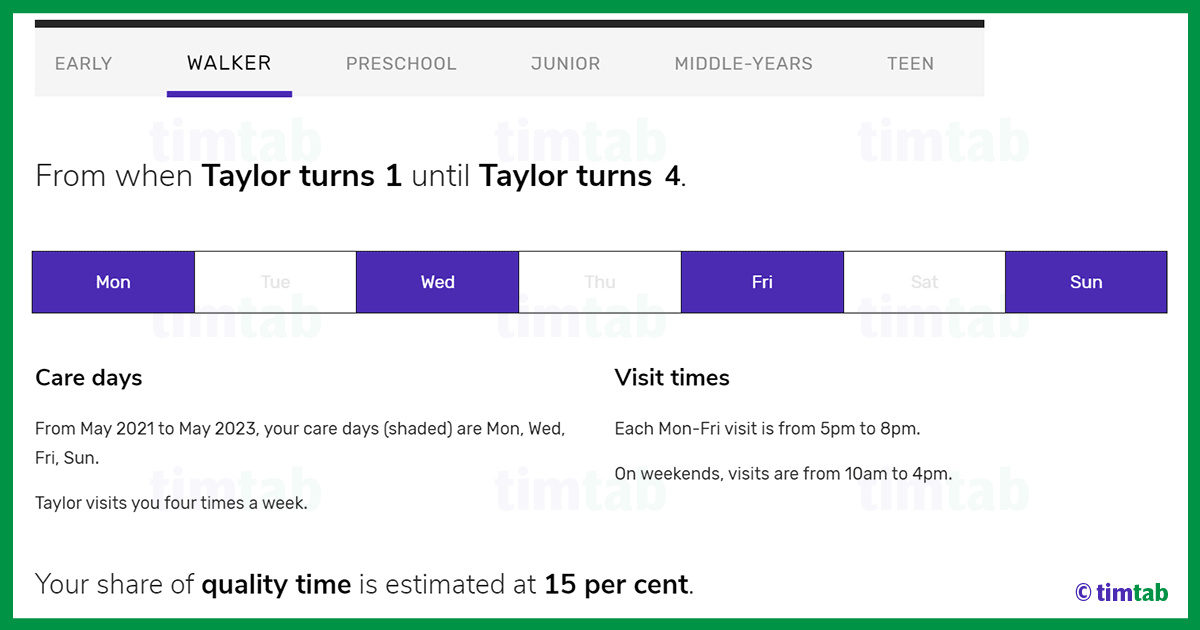For toddlers – children aged one, two or three – joint physical custody arrangements should be considered. Toddlers can handle overnights away from the primary carer. But age-appropriate visitation limits are needed.

Andrew Lancaster
TIMTAB FOUNDER
May 5, 2020
Share article:
If you want the best custody arrangements for your toddler, optimized schedules are available from Timab. The software will also draft a parenting plan for you.
Here are three of Timtab’s most popular custody schedules for very young children. After showing the examples, we’ll compare the differences between good and bad visitation arrangements for toddlers.
Schedule 1: Tuesday, Thursday and Saturday or Sunday Visits

The above schedule is great for a toddler if the parents live reasonably close to one another. The child visits the parent with less than half the care time – the “minor-care” parent – three nights each week. Visits are Tuesday, Thursday and once each weekend, alternating between Saturday and Sunday.
In this and other examples, each changeover is 9am on weekdays or 10am on Saturday or Sunday. But swap times can be easily adjusted. For example, during the working week, you could schedule collections for after work.
The joint-custody schedule works beautifully for a toddler because:
- Visits with the minor-care parent are predictable, happening after short absences of one or two days.
- The child is never away from the primary carer for more than 24 hours.
- Parents have the same care days from Monday to Friday each week, making it easier to organize daycare and work rosters.
Most importantly, the schedule is well balanced. The child is able to form strong and secure attachments to both parents.
Schedule 2: Monday, Thursday and Saturday Visits

Schedule 2 is a variation on Schedule 1. The simpler arrangement has the toddler visiting the minor-care parent every Monday, Thursday and Saturday.
Schedule 2 has a repetitive weekend visitation pattern, which may be considered undesirable. But the timetable is preferable where parents live more than about 20 minutes apart. Having a visit every Saturday morning to Sunday morning reduces the need for changeovers during the working week.
Schedule 3: Frequent Non-Overnight Visits
A different approach is for the toddler to spend every night at the same home and only visit the non-custodial parent in the evenings or during the day.
- A schedule lacking overnight stays is more common for babies than toddlers.
- This kind of restriction may be appropriate if the toddler and non-custodial parent don’t yet have a strong relationship.
The best schedule without overnight stays has the toddler visiting four times a week: on Monday, Wednesday, Friday and Sunday. These visits could happen, for example, from 5pm to 8pm on weekdays and 10am to 4pm on weekends.
A big advantage of the schedule is tremendous stability for the toddler. While seeing the non-custodial parent often, the child effectively lives in a single home.
But the key disadvantage is that the toddler has limited hours with one parent. Therefore, they miss out on many of the benefits of shared parenting, at least until they transition to overnight visits. And numerous swaps are needed to achieve a modest number of contact hours with the non-custodial parent.
Good Custody Arrangements for Toddlers
A good custody arrangement for a toddler has the following key elements in place. Achieving all of them is possible if the parents live reasonably close together.
Absences from the primary carer are short
The simplest and most guaranteed way to ensure a toddler feels secure is to keep absences from their primary carer short, such as no more than 24 hours. Toddlers can feel stressed from being away from a close attachment figure for long periods.
You can also go for 50/50 visitation and try to ensure a toddler is never away from either parent for long. However, 50/50 custody combined with short visits is difficult to do logistically.
- Keeping a toddler in daily contact with two parents who live apart is tough and probably not worth the amount of back and forth required.
- That’s why 60/40 schedules are usually recommended for toddlers.
See also: 50/50 Custody Not Working
Both parents have significant individual roles
A good parenting arrangement also involves the “minor-care” parent heavily in their toddler’s life. Visits are both frequent and of an age-appropriate length.
Children do best by having close relationships with both their mother and father. And you need close parent-child relationships for successful co-parenting. More time with the “minor-care” parent:
- improves the relationship, making the toddler feel secure and happy when visiting, and
- helps the parent strengthen their skills in looking after the child.
Consistent care pattern from Monday to Friday
A parenting timetable for a toddler should normally have the same Monday to Friday pattern every week. Looking after toddlers is intensive and can require parents to have days off work or book childcare. Making arrangements is generally easier if each parent has the exact same days on or off every week.
Travel requirements are manageable
Going back and forth between homes is part of the cost of raising a toddler as co-parents. The toddler benefits from getting to see both his or her parents often. Parents also benefit by getting frequent visits as well as rest breaks.
While the toddler years can fly by quickly, the travel costs of a custody arrangement also need to be considered. A child should spend as much time with the “minor care” parent as is practical given the difficulty of transporting him or her between homes.
Older siblings are factored into the arrangements
A good custody arrangement for a child considers older siblings. Older children have different requirements, especially if they are attending school. Going between homes is also less of a big deal for a toddler who is always traveling with their big brother or sister.
Custody schedules for multiple children are available from Timtab. They account for the ages of all children involved.
Bad Visitation Arrangements for Toddlers
A bad visitation arrangement might harm a toddler’s relationship with one or both parents, make the little one feel insecure or be impractical for the parents to follow. Here are some of the ways that parenting plans for toddlers can fail.
A parent is marginalized in their toddler’s life
A common complaint from fathers in particular is that they are marginalized as a parent by getting too little time with their toddler. The mother-child relationship is prioritized at the [unecessary] expense of the father-child relationship.
Provided the parents are competent and live reasonably close together, neither should be marginalized and joint physical custody should be considered. Schedules can be created to support strong bonds between a child and both parents.
There is no evidence to support postponing the introduction of regular and frequent involvement, including overnights, of both parents with their babies and toddlers. Maintaining children’s attachment relationships with each parent is an important consideration when developing parenting plans.Social Science and Parenting Plans for Young Children: A Consensus Report
We should remember that parents and children are adaptable. Children can form brilliant, secure relationships with people other than their primary carer. And parents can learn how to look after children really well by spending sufficient time with them.
Primary carer and home are not seen for days
Not seeing their primary carer and usual home for multiple days – whether that is two, three or more days – is risky for toddlers. Multiple days is a long time in the mind of a very young child.
While the psychology of children and absences can be studied and debated, I don’t believe it makes sense for toddlers to be kept away from their main caregiver for very long. Toddlers may struggle to understand what is happening when they leave their home base for longer than an overnight visit.
With good alternatives available, a visitation schedule is less-than-ideal if it includes long absences from the primary carer.
Schedules with alternating blocks of days
You may see custody schedules for toddlers that consist of simple alternating blocks. Some examples are: (i) alternating every 2 days (ii) the 5-2 schedule (iii) every 3rd day schedule (iv) 4-3 schedule (v) 4-3-4-4 schedule (vi) every weekend schedule and (vii) every extended weekend schedule.
Unfortunately, while they are simple to explain, none of the schedules are very good. Most of them alternate care days during the week. For example, a parent may provide care on Monday, Tuesday and Friday one week and on Wednesday and Thursday the next. That can make arranging work or daycare difficult for one or both parents.
A couple of the schedules have one parent getting all or most of the weekend time while the other parent provides care during the week. Although this may work for some co-parents, for most it doesn’t.
- Unbalanced schedules like these can be unfair, such as by preventing one parent from working and the other from doing any child-free activities on weekends.
- As well, they somewhat limit the kinds of activities each parent can do with their child.
Such schedules are made up and lack any real science behind them. In contrast, optimal, customized schedules are available using Timtab AI software. The technology accounts for numerous quality factors.
Related articles
Top tips to co-parent a toddler… communication, love, prep and boundariesChild visit transport responsibility… who picks up or drops off the kidsEasy parent communication plan… co-parenting without conflict



